Environment
1. Overview
KOICA has continuously fostered the ability of developing countries to manage and protect their environments as a way to achieve sustainable development. KOICA’s environmental focus aims to improve the laws and institutions of cooperating countries through diverse programs regarding environmental topics. These topics include waste, forests and water quality. The goal of these projects is to provide aid for the procurement of environmental management facilities and for the development of human resources, thereby reducing harm caused by pollution. From 1991 to 2010 the amount of aid assigned to environmental sectors totaled USD 62 million, translating to 6% of KOICA’s total budget. Although not the largest portion of KOICA’s aid budget, the Korean government’s “Green Development and 5 Year Plans”will increase green ODA to 30% of all ODA spending by 2020.
2. Performance
At KOICA’s founding in 1991, the size of aid for the environmental sector amounted to approximately USD 800,000. By 2010, this figure had increased over 133 fold to USD 10.7 million. The main reasons behind this drastic increase was a change in attitude toward the environment both internationally and within the cooperating countries, the support of policies implemented by the Korean government in respect to green growth and the participation of private firms in the field of environmental technology.
The environmental sector aid provided by KOICA at its establishment consisted primarily of invited training programs, and small-scale projects involving the dispatch of specialists and volunteer groups. During that period, there was no significant awareness of the importance of environmental issues or policies regarding the protection of forests, coasts and the environment as a whole. Therefore, KOICA established training programs addressing these issues along with an introduction to Korea’s strategies in dealing with the matter. By the beginning of 2000, both the size and quality of aid was improved. From a small-scale operation where there were few aid beneficiaries, the number of projects with visible results significantly increased. This resulted in the direct implementation of projects into the environmental policies of cooperating governments.
The first environmental sector projects operated in the reforestation field. These included reforestation projects in Indonesia and Myanmar, with a special focus on the management of desertification in China due to the closely linked yellow dust phenomenon present in Korea. However, sustainable development was not simply limited to the field of natural resource management, but necessitated a complex relationship between economic development, social integration and environmental preservation. For this reason, the environmental sector consisted of many diverse fields. The demands of the cooperating countries became diverse as well. Therefore, projects needed to be formulated which could establish and improve waste, groundwater management, infrastructure to measure air and water quality and other related Master Plans. The new projects also had to find a strategy to integrate these fields with each other. From 2000 to 2010, together with invited training programs and specialist dispatches, KOICA initiated 41 projects and development study projects.
Of the projects and development study projects, 67.5% were conducted in Asia, 19.7% in Africa, 8.6% in the Middle East, 1.6% in CIS and 2.4% in Central and Southern America.
[Table 2-1] Main Environmental Problems in Different Regions
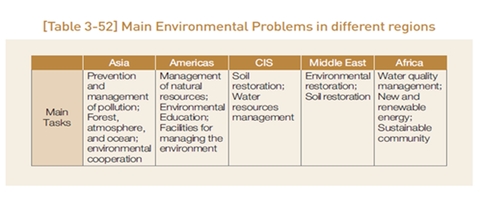
3. Strategy and Institutional Improvement
KOICA is formulating step-by-step plans to implement the Korean government’s “Green Development and 5 Year Plans.”The aim is to increase the proportion of green ODA among all ODA to 30% by 2020. It has established a plan to mainstream the environment in ODA projects from the planning stage to the project stage. As a result, the number of environmental sector related projects are expected to increase continuously. Not only does aid in this sector lead to sustainable economic growth in development countries, it is also an issue that requires cooperation within the global community in order to tackle global issues. By providing a project system suitable to handle the expanding the size of its projects, KOICA strives for new projects that simultaneously pursue environmental protection and economic development.
Because environmental problems are closely related to all human activities, it requires the attention and participation of government from the initial stages of policy formation. However, the awareness of the importance of the environment amongst people in the cooperating countries still remains insufficient. Because quantitative and visible results of environmental project are difficult to obtain, environmental problems remain a low priority of governments in most countries.
Accordingly, for aid to be distributed equally within the cooperating country, KOICA intends to provide aid by integrating four sectors: 1) institutional competence strengthening, 2) human resource development, 3) expansion of environmental management facilities, and 4) increased awareness of environmental value. In order to secure sustainable growth, the principle response capabilities of the cooperating country should be cultivated. It will also be provided with reasonable technical assistance appropriate for the environment that region. The simultaneous environmental and economic development of the cooperating country will eventually be promoted through these measures, leading to the formation of a Green Partnership with the country.
For the implementation of the above plans, the environmental projects will have two main goals of strengthening environmental pollution management capabilities and strengthening capabilities concerning the preservation of the environment. In addition, KOICA has established seven goals, including the improvement of waste management and forest preservation capabilities. These goals will be met by utilizing Korea’s comparative advantage and experience in these fields. The objective of the environmental pollution management capability improvement projects is to further reduce the main form of pollution in cooperating countries. The goal of the projects concerning improving capabilities regarding the preservation of the environment is to work towards solutions of global problems of environmental protection and to improve the lives of those most at risk.
[Figure 3-1] The Environment Sector Strategy
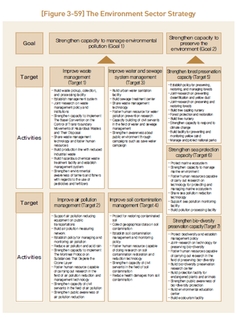
In 2009, KOICA was selected as the organization to implement the “East-Asian Climate Partnership.”Since then, environmental projects emphasize the importance of reacting to climate change. Since 2000, climate change has become the most important issue facing the global community. To tackle the increasing demands of a growing global population, developing countries act as strong combatants against climate change. They initiate projects in solar and bio-energy, enhance Clean Development Mechanism (CDM) and increase the supply of renewable energies. Additionally, they develop infrastructure to observe and measure climate change to inspect its negative effect on the environment. To further this work, KOICA combined its projects with those of the East Asian Climate Partnership.
The establishment of project guidelines and the creation of responsible organizations were necessary to improve institutions involved in projects. First, the Global Issue Team was founded in 2006 (it was later renamed the Women’s Environmental Team in 2007) to improve the systematic support and specialization within the environmental sector. As a result of its formation, KOICA began building the foundation for a project implementation system to meet the demands of an increasing number of environmental projects. By 2005, there was a comprehensive evaluation of the system that operated the environmental sector projects. The contribution of the cooperating countries led to the formation of a prioritized action plan and classification system customized for each project type. As a result, effectiveness and systematization of the implementation of projects improved. In addition, the OECD/DAC designated the environment as a cross-cutting sector of sustainable development. This further led to the designation of the environmental sector as one of the seven sectors to receive support at the 2007 official development assistance midterm plan and revitalized the relevance of the environmental sector in terms of organizational issues.
Second, in 2008 KOICA arranged the “Environment Guidelines for Sustainable Development”to mainstream the environment into ODA projects in every stage of planning. KOICA environmental guidelines define the procedures and functions of environmental impact assessments that should take precedence during aid projects. They also reflect the recommendations of the OECD/DAC’s special review. These environmental guidelines contain the management measures for plan formulation and the possibility of completion after considering the environment of the cooperating country. The projects were given a classification of A, B or C depending on the level of risk. Environmental impact assessment and environmental impact reduction plans are recommended before the start of a project. These measures will provide the foundation upon which the development of future aid systems will take place. The Agency is in the process of strengthening the capabilities of employees involved in environmental issues. To reflect these guidelines in real projects launched, training for inter and intra agencies was conducted in 2009. Issues concerning applicability and requirements for each project type are being investigated to formalize these processes.
Third, as a result of the increase of environmental sector projects, KOICA has formed interagency pools and is actively promoting the participation of specialist individuals and organizations in cooperative projects. Nine sectors, including water treatment, sewage and energy, pilot surveys and implementation discussions (specialized in respect to the fields they are involved in) are used to improve specialization and efficiency. They also strengthen relations among cooperating organizations.
Source: Korea International Cooperation Agency. 2011. 20 years of KOICA 1991-2010, Translated by Institute for Development and Human Security, Ewha Womans University. Seoul.
4. Best Practices
A. Indonesian Rainforest Seed Management and Development Projects
The goal of this project is to develop and distribute high quality forest tree seeds. This will restore wastelands and form an efficient basis for land development and increase forest productivity. The first step of the project to distribute superior seeds is already successfully underway in the Indonesian rainforest under the“ Indonesia Forest Improvement and Nursery Construction Project”supported by the Korean government. The project was requested as a follow-up project that conducted active seed management and development.
This project was the first in Indonesia to implement superior seed cultivation and long-term storage technologies. It is credited as the foundation of Indonesia’s forest restoration plans. The Rumpin nursery center is able to conduct on-site training in this field. It is anticipated that these projects will spread across the region.
[Figure 4-1] Acquiring samples of superior stock
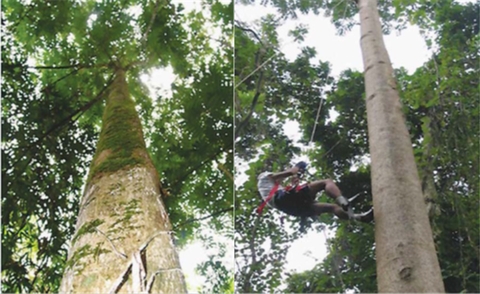
[Figure 4-2] Seed analysis laboratory at Rumpin sapling nursery

B. Industrial Wastewater Treatment Capacity Reinforcement Project in Vietnam
Vietnam’s Environmental Protection Act Amendments in 2005 placed as its major goals the prevention of industrial pollution and the systematic management of the water system. These goals strive to reduce pollution produced by economic development. At the end of 2005, the Vietnamese Ministry of Planning and Investment (MPI) requested the Industrial Wastewater Treatment Capacity Reinforcement Project after assessing the Industrial Pollution.
Prevention Aid Project which was implemented in 2003 as an outstanding ODA project. The ministry wanted to enhance its performance and expand its application. The project greatly increased the capacity of the Vietnamese environmental technology research center and its researchers by increasing environmental knowledge, transferring expertise skills and performing laboratory operations. The degree of improved skill level was so great that experiment requests came in from inter-agencies and other labs. In addition, in cooperation with Korean specialists, it is anticipated that the practices from such experiments as the water quality tests of the Cau River and the water treatment measures for butcheries will be implemented nationwide.
[Figure 4-3] Environment Research Center Equipment
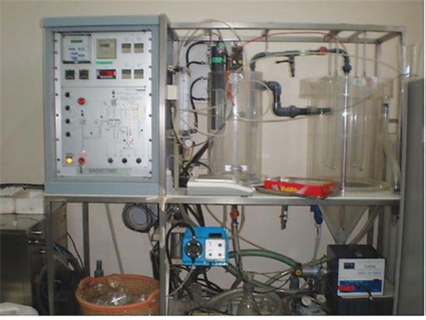
[Figure 4-4] Waste water treatment facility near butcher facility
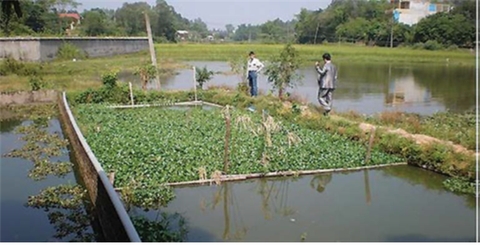
Source: Korea International Cooperation Agency. 2011. 20 years of KOICA 1991-2010, Translated by Institute for Development and Human Security, Ewha Womans University. Seoul.
